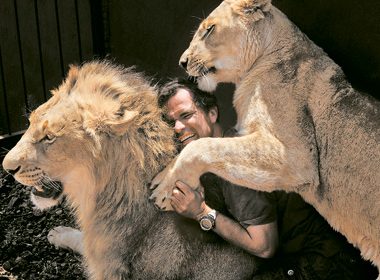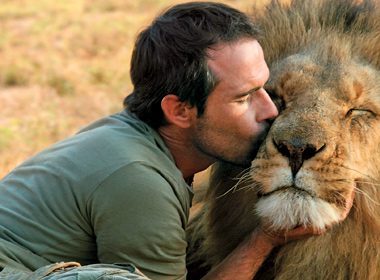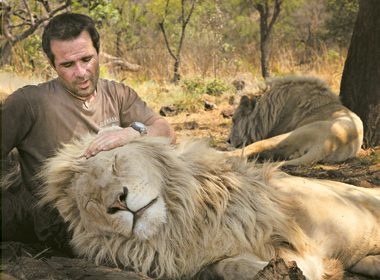
When Kevin Richardson steps through the gate onto a stretch of pristine South African grassland, time appears to ripple. The disturbance causes a momentary abatement in the roar of the cicadas; the only sound is the crunch of dry grass under his boots. Then the air shivers, and half a metric ton of flesh and muscle bursts from the veld: an adult lion and lioness, their movements so fluid they seem poured from the bush. Before Richardson can prepare himself, the cats paw his head and bring him down.
“Bobcat! Gabby!” he coos. “Come here, my babies!”
The lions flop on top of him like kittens at play. Over the past 17 years, millions have watched similar encounters on news segments and nature channel shows: Richardson, wearing shorts and a T-shirt, attacked by several of the planet’s most fearsome predators. Just as viewers brace themselves for a bloodbath, a love-in ensues. No number of YouTube clips, however, can rival a live performance. The animals smell like dust and death. They are not tame; they are untameable. Somehow, because of a skill or intuition he cannot name, Richardson appeals to the softer elements of their nature.
We have seen the likes of this before, and we know how it ends. Crocodile Hunter, Grizzly Man, Siegfried and Roy-all killed or injured by animals they claimed kinship with. Richardson, who has known these lions since they were babies, insists he’s different, but is aware of the risks. “If I told you there are no issues associated with what I do, I’d either be a liar or mentally unstable,” he says, as Bobcat nuzzles his neck.
No animal behaviourist has ever endorsed Richardson’s activities-the prevailing theory is that lions are too unpredictable to be trusted, no matter how docile they may appear. The more persistent criticisms come from park rangers who often face considerable danger from large carnivores while on patrol. Two years ago, a ranger at Kgalagadi Transfrontier Park, a preserve bordering Botswana, barely survived an attack where he was dragged off an open truck by a lion that grabbed his leg between its teeth. It’s the kind of threat 27-year-old Mosa Masupe faces every day. Masupe is a ranger in Botswana’s Mashatu Game Reserve, home to several prides. He has followed Richardson’s career ever since he first surfaced in the media in 2000 as the “Lion Whisperer,” and like many rangers who hear about Richardson, Masupe believes a gruesome mauling is inevitable. “Those lions will kill him,” he says.
In 2001, a lion called Tsavo busted Richardson’s nose with a blow from its massive paw. His arms and legs are mapped with scars. Even a gentle love bite could nick a jugular, leaving Richardson to bleed out in the grass, alone. “I’m not really worried, because it’s all I know,” says Richardson’s wife, Mandy, who has been with him for over 13 years and helps raise their two young kids. “It’s what he’s done since I met him. He’s so passionate about his work that it’s contagious.” So contagious that for years Mandy also worked as Richardson’s public relations point guard, helping build his rough-and-tumble reputation. “Have you seen any untoward movements from these lions?” he asks. “There’s no reason for me to hit them or subdue them. They’re lovable, social cats, man.”
Perhaps. But does a word like “lovable” apply to wild creatures whose consciousnesses we cannot fathom? Or is it a case, as the South African writer J.M. Coetzee once put it, of there being “no limit to the extent to which we can think ourselves into the being of another”? Clearly, Richardson believes that such empathy, at least when it comes to lions, knows no bounds.

Richardson has described himself as a self-taught zoologist, but he is something deeper-a medium between the world of wild predators and those who present a terminal threat to their survival. In the wild, lions are menaced from three main sectors: the relentless spread of agricultural land, in which 75 per cent of the animals’ natural habitat has been converted into grazing fields for cattle; wildlife clashes, where farmers kill hundreds of lions a year in retaliation for attacks on livestock; and endemic poaching by locals, who can make the equivalent of their annual incomes-about $6,000-by shooting a single lion and selling the meat and bones on the black market. (Lion bones are an acceptable substitute in Asian tiger bone wine, said to boost virility. A status symbol for an exploding Chinese middle class, a case of the potion can fetch as much as US$25,000 at auction.)
As a result, lion populations are being decimated. In 1950, over 200,000 roamed Africa’s vast savannahs. The most recent estimates put the figure at 35,000. The International Union for the Conservation of Nature currently classifies the species as “vulnerable.” Stuart Pimm, a conservation biologist at Duke University in North Carolina who has spent his career studying present-day extinctions, calls it “a full-fledged crisis.” In addition to the ecological costs of knocking off an apex predator, Pimm describes the loss of lions as an ethical defeat. “It’s a measure of the fact that we aren’t being good stewards. What sort of planet do we want to hand to our children and grandchildren?”
But as bad as things are for wild lions, notes Richardson, life is just as tenuous for the 5,000-plus in captivity in South Africa, raised to be slaughtered like chickens. (With the country’s wild lion population averaging 3,000, that means the majority of South Africa’s lions are in cages.) Most captive lions begin their careers as cubs on breeding farms, enjoying the attention of countless visitors. The cats will keep generating money until they’re six months old, at which point tourists will pay as much as $800 for an experience called “walking with,” in which a handler and his guests stroll through a patch of veld with a lion. Twelve months later, no longer adorable, they become fodder for tourists in a practice known as “canned hunting.” In 2007 alone, 16,394 foreign hunters arrived to kill an estimated 46,000 animals, an industry the government considers “a sustainable utilization of natural resources.” According to one report, 5,892 dead lions were exported from the country between 2001 and 2011. The majority were slaughtered in canned hunts.
In his videos, Richardson’s roughhousing showcases these “natural resources” as warm-blooded creatures to an international audience. As his YouTube views rack up, so, too, does his ability to publicize the plight of captive lions and, more broadly, the perils facing a shrinking wild population. Wrestling lions, however, is the easy part. Saving them is the real challenge.
While Richardson’s ruggedness suggests he was born in the bush, his clan hails from the lower-middle-class Johannesburg suburb of Orange Grove, where citrus orchards long ago gave way to family homes with postage-stamp-size lawns.
When Richardson was three or four, his dad helped him rear a baby bird that had fallen out of its nest. Dazzled by the experience, Richardson began to nurse other birds, until, by the age of seven, he acquired his first moniker: “The Bird Boy of Orange Grove.” Weavers, pigeons, mourning doves-broken birds by the dozen were brought by neighbours to the family’s home, and Richardson would add them to his growing aviary.
When Richardson was in his early teens, his father died. He acted out, drank heavily, stole cars, even rolled his sister’s vehicle in a crash. He began to lose interest in his birds and one day set the flock free. While he once hoped to study veterinary science, he was lucky to make it into university at all, and even luckier to escape with two years of zoology and a bachelor’s degree in physiology and anatomy. His work as a physical trainer eventually landed him a job at a Johannesburg facility called Lion Park. But Richardson was barely interested in his duties. He had fallen in love with two lion cubs named Tau and Napoleon.
He doesn’t properly understand why, on his first visit, he stepped inside the pen with the youngsters. Richardson had ridden superbikes, flown planes-so youthful machismo may have played a part. Still grieving his father, Richardson suspects he was driven by the need to master his fear of death. Regardless, the impulse was foolhardy. “At six months a lion cub is big,” he explains. “Check out his claws, his teeth-the thing can make a mess of you.”
No sane, unarmed wrangler will stay in an enclosure with a lion older than two and certainly no older than four. Richardson ignored that policy and spent as much time with the brood as possible, bonding as they grew into ornery adolescents and then matured into strapping adults. He discovered-as everyone else at the park soon did-that he had a sixth sense when it came to the cats. He could ask them to stroll alongside him, to roll on their backs to accept a tummy rub. He used no coercion-no sticks, no pepper spray. Lions, he learned, are hugely social, and if welcomed into the pride, he wasn’t just safe, but loved.
And so a brand was born. At 22, Richardson became a star wrangler at Lion Park-a glorified zoo where his antics wowed guests eager to get a taste of the bush in a contained setting. But he realized that, by emphasizing Tau and Napoleon’s cuteness, he was contributing to a trend that meant more cubs doing “cub duty” in competing parks, and thus more lions disappearing when they became too old to manage. “You could say I was part of the problem,” says Richardson.
If he was to do right by the animals he loved, he needed to both stoke his celebrity and eliminate the need for it to exist. Richardson began thinking about moving away from Lion Park and acquiring a facility large enough to let his captive lions roam free for the rest of their lives.

Richardson pilots a four-by-four through the dirt tracks of Welgedacht Game Reserve, 50 kilometres north of the South African capital of Pretoria. A year ago, with the help of donors, the Kevin Richardson Wildlife Sanctuary was established here, on a privately owned plot comprising 1,200 hectares of rolling grassland. The sanctuary, which also includes hyenas and black leopards, is Richardson’s first opportunity to run a park entirely how he sees fit. Thirteen electrified enclosures, each about a hectare in size, shelter Richardson’s 26 lions of various ages, many of which previously lived at Lion Park.
Richardson parks his four-by-four and makes for one of the enclosures. Two lionesses, Meg and Amy, lope up, and he’s on the ground in seconds. Richardson has known the sisters for 11 years, but after he left Lion Park, they were sold to a breeder and joined a pride that was too large. Scared they were headed to a hunting shop, Richardson purchased the animals back.
Retrieving Meg and Amy brought home the importance of being in control of his own facility. Outside the sanctuary, the pair would likely be pawns in a lucrative industry where hunters pay as much as $58,000 to gun down a full-grown male and up to $10,000 for a female. The experience also inspired him to redouble his efforts at curtailing the canned hunt-joining conservation groups in directly lobbying the South African government; raising awareness through fundraising and social media campaigns; giving seminars across the country and abroad about the more repugnant aspects of the killings; and working with wildlife NGOs, most notably Protecting African Wildlife Conservation Trust, that have outreach programs with landowners.
The fear is that the industry is simply too profitable to stop locally. Richardson’s hopes-and the hopes of environmentalists around the world-rest with the U.S. Fish and Wildlife Service’s recent decision to look into whether the African lion requires protection under its Endangered Species Act, which would prevent hunters without permits from bringing lion trophies into the country. The one-year review of the classification would also likely influence whether the Convention on International Trade in Endangered Species of Wild Fauna and Flora (CITES) decides to lift African lions to a CITES 1 categorization-also under review.
“Lions are currently CITES 2,” explains Richardson, “which means it’s totally legal with permits to hunt them and export the trophies.” CITES 1 categorization would ban the exportation of heads, pelts, meat and bones to the United States, as well as the other 178 countries that implement CITES. Considering that the U.S. is by far the canned hunt’s largest customer base, “it would stop the industry in an instant,” says Richardson.
The last thing Richardson wants, however, is to end up with more lions in his sanctuary, a big reason his females are on contraception. His aim is for the captive population to plummet, and that means placing a nationwide moratorium on lion breeding-something advocated by many conservation groups, including Four Paws, an international animal-welfare organization that runs a lion sanctuary in South Africa.
Richardson leans back against a now supine Meg, ruffling her ears. “If only tourists did the math and said, ‘Hey, where do all these cubs end up?'” he says. “Would you come and pet a cub knowing that, as an adult, he’s going to get slaughtered? Would you be happy?”
Lion Saving
A week or so before Christmas in 2013, during one of the violent storms that announce the arrival of South Africa’s rainy season, a lion called Thor was felled by a lightning strike. Thor was a white lion in Richardson’s sanctuary, named for the Norse god of war and thunder. The lion had starred in many videos and documentaries, most notably the epic White Lion, which turned him into a matinee idol. The circumstances of his death seemed like a resounding tribute from above.
Richardson’s relationship with Thor was not without its troubles. On a film set five years ago, feeling the pressure of all that money spooling through the camera, Richardson prompted Thor to attack an animatronic lion one time too many. With staggering speed, the 300-kilogram animal lunged and grabbed Richardson’s forearm in his jaws, employing just enough pressure to make his intentions plain.
In the only way he was able, Thor reminded Richardson that lions are not circus performers and that the intersection between friendship and exploitation had been crossed. Richardson was ashamed. It took three years for Thor to forgive him and invite the Lion Whisperer back into his social circle with a guttural grumble.
“When he died, I don’t think I’ve ever cried more,” says Richardson. The essential aspects of Thor’s character-his solitariness, but also his independence and pride-are why Richardson’s mission is to run Welgedacht as a game park without a captive lion population once his own brood dies off. “I want no lions in enclosures,” he says. “If that happens, then I know we’re doing something right.”
The long-term survival of lions is now a priority for many conservationists. If you want to help, check out the following groups, which support habitat restoration programs as well as education initiatives in local communities.
Lion Conservation Fund: lionconservationfund.org
Global White Lion Protection Trust: whitelions.org
National Geographic Big Cats Initiative: donate.nationalgeographic.org